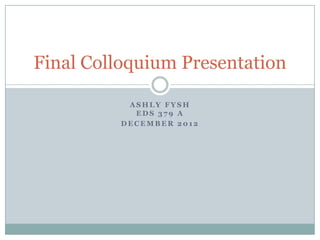
Final colloquium presentation 379 a
- 1. Final Colloquium Presentation ASHLY FYSH EDS 379 A DECEMBER 2012
- 2. My Teaching Placement Kearny School of International Business Contemporary Voices of Literature – Grade 12 43 students, 5 English Learners, 10 re-designated as “fluent” English speakers.
- 3. My Thoughts on PACT… I encountered a few difficulties in putting together my lessons for the PACT teaching events. I had the most difficulty connecting my lessons and ensuring that they would lead to the fulfillment of my overarching learning objective. Overall, I think that I was highly conscientious of incorporating varied activities into my lesson plans that would help make the content accessible and comprehensible to my students. I also think that I had integrated a strong balance of various formal and informal assessments to monitor the progression of student learning.
- 4. Creating an Effect Environment TPE 10: Instructional Time Establish procedures for routine tasks and manage transitions to maximize instructional time. The students are usually assigned a warm-up activity and an exit slip every day. The students write both entries in their journals, and I check their journals before they leave. The exit slip serves as a “closure” for the day since it usually asks students to reflect on certain activities or readings we completed earlier in the period. This task, along with the warm-up has helped establish a daily routine in our classroom.
- 5. Creating an Effect Environment TPE 11: Social Environment Promote student effort and engagement and create a positive climate for learning. After our class read Hamlet, I asked the students to prepare for a “Socratic Seminar”. Every student was required to participate by writing and sharing 3 questions about the play to their peers. I also reminded the students to “bring a respectful attitude” to the seminar, and emphasized that they must be polite and respectful to their peers and their peers’ views. This helped create a positive, encouraging environment for the students during the seminar.
- 6. Engaging and Supporting Students in Learning TPE 4: Making Content Accessible Vary instructional strategies according to purpose and lesson content. The objective for the “squiggles” activity was for students to be able to identify and analyze the use of imagery and figurative language in Hamlet’s “to be, or not to be” soliloquy. I thought the squiggle activity would be a great way to fulfill this objective, since the squiggle activity asks students to draw images that come to mind as they listen to Hamlet’s soliloquy. The students were able to demonstrate their analyses of imagery in their presentations of their squiggles.
- 7. Engaging and Supporting Students in Learning TPE 5: Student Engagement Use community resources, student experiences, and applied learning activities to make instruction relevant. I asked the students to complete this Quick-write before reading about the creation of life-long customers in Fast Food Nation. The activity asked students to reflect on their personal experiences to help them better relate to ideas found in the text.
- 8. Engaging and Supporting Students in Learning TPE 6C: Developmentally Appropriate Practices in Grades 9-12 help students to understand connections between the curriculum and life beyond high school, and they communicate the consequences of academic choices in terms of future career, school and life options I referred back to the “essential question” several times as our class read Hamlet. After reading certain scenes and speeches in Hamlet, I asked students to explain how they might be able to relate to the characters and scenarios in the play.
- 9. Engaging and Supporting Students in Learning TPE 7: Teaching English Learners Based on appropriate assessment information, they select instructional materials and strategies, including activities in the area of visual and performing arts, to develop students’ abilities to comprehend and produce English. After showing students a few “modern” adaptations of Hamlet, I assigned video/live performance adaptations of Hamlet as the concluding project for the unit. The project required students to use their understanding of a scene from Hamlet and adapt it into a new scenario. The activity required students to both comprehend and produce English, since the students were asked to create a script, performance, and analysis (that “defends” their artistic decisions).
- 10. Assessing Student Learning TPE 2: Monitoring Student Learning During Instruction Anticipate, check for, and address common student misconceptions and misunderstandings. The students were asked to complete a “study guide” for every scene of Hamlet. The study guide asks students to write a summary of the scene, recall important quotes, take note of literary devices, and ask questions and comment on the text. Before reading the scenes together in class, I asked students to read their questions and comments. This provided me the opportunity to address the students’ misconceptions and questions before reading.
- 11. Next Steps… As an evolving practitioner… I realize that I need to be more knowledgeable about preparing instruction and teaching materials for English learners. About 10% of my current class is made up of English learners, and I would like to ensure that my curriculum meets their needs. (TPE 7-Teaching English Learners) I want to make sure that my curriculum is not only differentiated for English Learners, but highly relevant and engaging for all of my students. I think this may be the most challenging but also the most exciting aspect of this career. I would also like to become a “connected educator”. I would like to use more media and technology in the classroom to supplement my lessons. (Student Engagement – TPE 5)
Editor's Notes
- Study guides include: brief summary of events, important quotes, literary devices, and a final section where they may make comments/and ask questions.